History Of Bread: Basic Food Of Man In Ancient And Contemporary Cultures Around The World
A. Sutherland - AncientPages.com - Bread has been known for millennia though its authentic history is lost in time. It is the primary food of man in almost all cultures worldwide.
The folklore surrounding bread was passed down through oral tradition, hieroglyphics found in ancient Babylonia and Egyptian tombs, and old records about bread left by ancient Chinese writers.
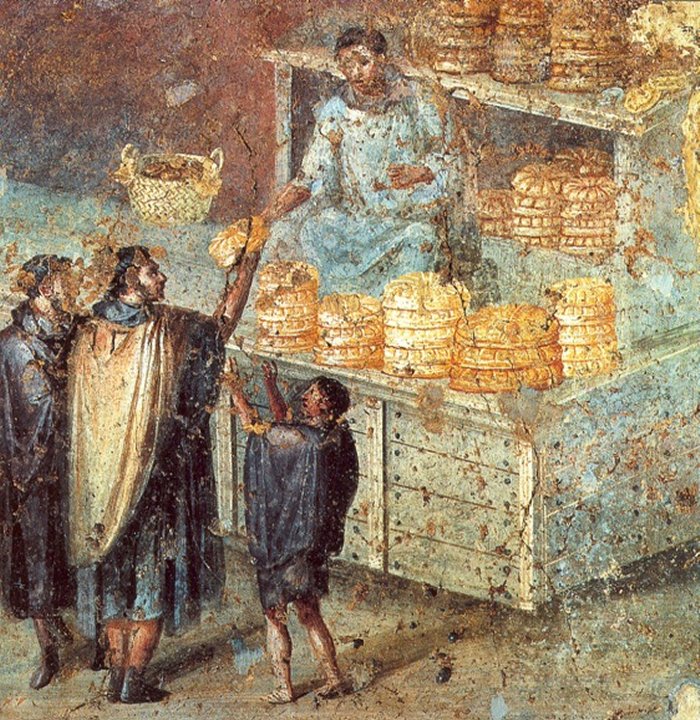 Sale of bread at a market stall. Roman fresco from the Praedia of Julia Felix in Pompeii. source
Sale of bread at a market stall. Roman fresco from the Praedia of Julia Felix in Pompeii. source
Bread played a crucial cultic role (for example, in the Old Testament) as well as cultural and symbolic. Christian tradition has been known as a widespread custom to bless each new loaf of bread with the sign of the Cross. Also, the Sacrament of Communion (flesh and blood, bread and wine) is essential in Christian imagery, symbolizing the blood of Jesus Christ.
In Judaism and Christianity, unleavened bread (prepared without yeast) is also symbolic.
It All Started With Herbs, Fruits, Nuts And Grinding of Grain
At first, people lived on fruits, herbs, and later nuts, which they included in their daily menu. The next step was grinding grain, recorded by early historians of Assyria, India, America, and China. The grain was softened with water (forming a paste) and sundried in thins slabs similar to pancakes (but with a hole in the center of each cake). Then these pancakes were stored for winter and seasons of drought. It was rather primitive baking that satisfied hunger, but it was long before wheat was grown.
This practice (easier to prepare in warm countries) was also popular among the Scottish and Scandinavian people, where the climate did not help make this kind of food.
First, Crude Ovens And Egyptian Bread Baking
The first crude ovens predated Babylonia by approx. 2,000 years. The first ovens consisted of holes in the ground dug to a depth of about four and one-half feet, and they were lined with baked mud. A fire was built over these holes, and the ashes were scraped to place the dough inside. A flat brick covered the top of the oven.
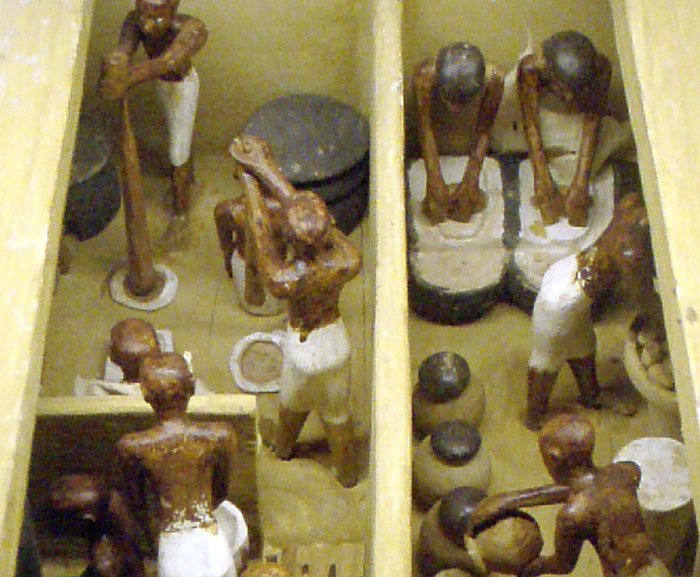 A funerary model of a bakery and brewery, dating the 11th dynasty, circa 2009-1998 B.C. Painted and gessoed wood, originally from Thebes. Source
A funerary model of a bakery and brewery, dating the 11th dynasty, circa 2009-1998 B.C. Painted and gessoed wood, originally from Thebes. Source
The first homemade, conical-shaped bread ovens have their beginnings in ancient Egypt. The baker’s oven was a dome-shaped vault. Egyptian texts mention at least 30 different, widely used, and enjoyed bread products. Baking bread was a well-organized activity in bakeries with large bread ovens.
The bread was a payment in kind for the Egyptians: wages and taxes were calculated in bread loaves. Ancient Egyptians sometimes paid their officials with good bread.
The paintings on the walls of the tombs in ancient Egypt show that baking around the 25th century BC was an art. The Egyptians were the first to introduce yeast directly into their bread. They also found that they could take a piece of dough from one batch and save it for the next day’s batch of dough. It was how the origin of sourdough started and is still used today.
With time, the construction of ovens developed. The first closed arch ovens were built in Rome, and this furnace gradually improved over the centuries.
The real gourmets of bread were the ancient Greeks. In the 3rd century BC, there had over 70 types of bread. The oldest bread that archaeologists managed to unearth comes from Crete (Greece), and its age is estimated at 6100 years. Initially, it was baked in ashes, later, in the first bread oven that was warmed up inside and open at the front.
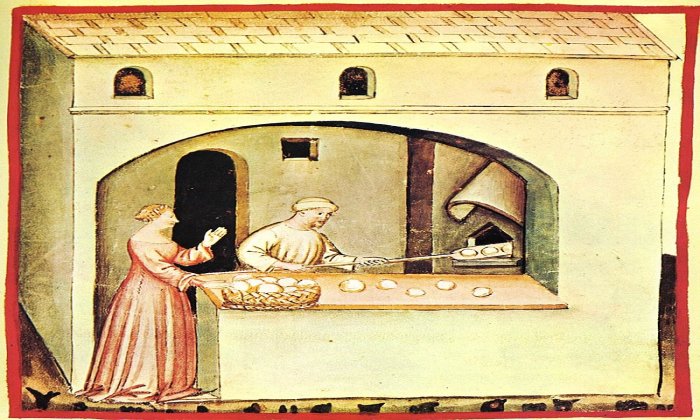 Bread shop, Tacuinum Sanitatis from Northern Italy, beginning of the 15th century. Image credit: Author unknown - Public Domain
Bread shop, Tacuinum Sanitatis from Northern Italy, beginning of the 15th century. Image credit: Author unknown - Public Domain
As early as the fifth century BC, there were over 300 bakeries owned by Greek bakers in Rome.
The Greeks passed on the artistry and the baking techniques to the Romans, who turned baking into a large-scale industry.
The ancient Romans became interested in bread at the turn of the eighth and seventh centuries BC. Bread-baking ovens soon became very popular in ancient Rome, and during the reign of Emperor Octavian Augustus (27 BC – 14 CE), there were about 300 ovens baking bread.
Large bakeries emerged in all Roman cities and had professional bread ovens where large quantities could be baked at once.
Bread Changed Over The Centuries
The appearance and properties of bread have changed significantly over the centuries thanks to significant improvements in baking techniques and various bread ingredients.
The most original form of bread was baked in ashes, on hot stones, grates, and metal sheets. Baking pancakes under a clay pot (bell) covered with hot ash gave rise to dome bakery ovens with a side hole, which in this form survived from Roman times almost to our modern times.
 Machine-made Shmura Matzo, eaten during Passover week. source
Machine-made Shmura Matzo, eaten during Passover week. source
Egyptians Baked Sourdough Bread Almost 4,000 Years Ago
The first documented production of sourdough bread dates back to ca. 1500 BC. Egyptians realized that when flour and water were left out long enough to ferment, the resulting dough increased in volume and could be baked into bread. When they fled the region, the Jewish people learned to make sourdough bread in Egypt and took that knowledge with them.
Then, sourdough bread became popular in Europe and the Middle East.
Bread For Pilgrims, Travelers, The Sick And Poor People
Bread in the early Middle Ages, even pre-Christian times, played a significant role in Europe in local rituals. In the form of a cake called ‘kolacz’ ( a type of pastry of Polish origin), it was an essential element of weddings and traditional ethnic holidays among the Slavs.
Later, medieval bakery art was developed in municipal bakeries and monasteries that had their bakeries producing bread for themselves. In addition, they were required to give bread to travelers, the sick, and the poor. As they owned grain mills, they had bread for pilgrims as well.
Industrial Bread In Portions - Sliced Bread
The one-loaf-at-a-time bread-slicing machine was one Otto Frederick Rohwedder of Davenport, Iowa. He was widely regarded as the inventor of industrial portioned bread. In 1912, Rohwedder patented an automatic bread slicer, but in 1917 a fire broke out at the factory where he was manufacturing his machine. It destroyed his prototype and blueprints.
Not until 16 years later did his machine finally appear on the market. The Chillicothe Baking Co. bought it, and their product called Kleen Maid Sliced Bread made a great success.
Written by – A. Sutherland - AncientPages.com Senior Staff Writer
Updated on June 2, 2023
Copyright © AncientPages.com All rights reserved. This material may not be published, broadcast, rewritten or redistributed in whole or part without the express written permission of AncientPages.com
Expand for referencesReferences:
Ashton J. The History of Bread From Pre-historic to Modern Times
Gobetti M & Gänzle M. Handbook on Sourdough Biotechnology,
Jacob H. E. Six Thousand Years of Bread
More From Ancient Pages
-
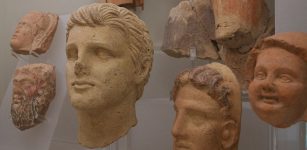 Intriguing Phenomenon Sheds New Light On The Etruscans
Archaeology | Sep 25, 2021
Intriguing Phenomenon Sheds New Light On The Etruscans
Archaeology | Sep 25, 2021 -
 Unknown Saxon Village And Bronze Age Artifacts Found Near Ely, Cambridgeshire
Archaeology | Sep 18, 2023
Unknown Saxon Village And Bronze Age Artifacts Found Near Ely, Cambridgeshire
Archaeology | Sep 18, 2023 -
 History Of Eyeglasses: One Of The Most Important Inventions Is Lost To History
Ancient Technology | Mar 10, 2016
History Of Eyeglasses: One Of The Most Important Inventions Is Lost To History
Ancient Technology | Mar 10, 2016 -
 Ostracism: Political Practice In Ancient Athens
Ancient History Facts | May 7, 2019
Ostracism: Political Practice In Ancient Athens
Ancient History Facts | May 7, 2019 -
 Rare Three-Bladed Arrowhead Hidden Under The Ice Was Last Touched By A Viking – Scientists Say
Archaeology | Jan 4, 2023
Rare Three-Bladed Arrowhead Hidden Under The Ice Was Last Touched By A Viking – Scientists Say
Archaeology | Jan 4, 2023 -
 Rosicrucians’ Secret Knowledge Of Atlantis, Pyramids And Extraterrestrial Visitations
Ancient Mysteries | Apr 17, 2017
Rosicrucians’ Secret Knowledge Of Atlantis, Pyramids And Extraterrestrial Visitations
Ancient Mysteries | Apr 17, 2017 -
 Fixing Archaeology’s Dating Problem – New Method Developed By Scientists
Archaeology | Sep 17, 2021
Fixing Archaeology’s Dating Problem – New Method Developed By Scientists
Archaeology | Sep 17, 2021 -
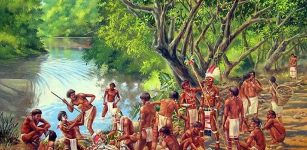 Taíno Indians Are Not Extinct – Ancient Tooth Reveals Indigenous Americans Still Have Living Descendants In The Caribbean
Archaeology | Feb 21, 2018
Taíno Indians Are Not Extinct – Ancient Tooth Reveals Indigenous Americans Still Have Living Descendants In The Caribbean
Archaeology | Feb 21, 2018 -
 Egyptian Royal Artifacts Found At ‘Ancient Buto’ Site, Egypt Probably Dated To King Psamtik I’s Reign
Archaeology | Jan 4, 2018
Egyptian Royal Artifacts Found At ‘Ancient Buto’ Site, Egypt Probably Dated To King Psamtik I’s Reign
Archaeology | Jan 4, 2018 -
 17 Mysterious Miniature Coffins In Scotland Remain An Unsolved Enigma
Artifacts | Feb 24, 2018
17 Mysterious Miniature Coffins In Scotland Remain An Unsolved Enigma
Artifacts | Feb 24, 2018 -
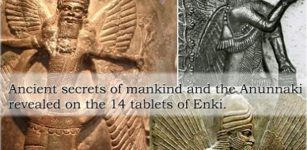 Ancient Secrets Of Mankind And The Anunnaki Revealed On The 14 Tablets of Enki
News | Jun 18, 2014
Ancient Secrets Of Mankind And The Anunnaki Revealed On The 14 Tablets of Enki
News | Jun 18, 2014 -
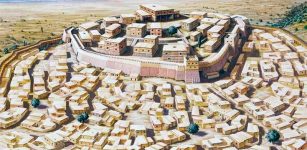 Ancient City Of Troy Was Destroyed By An Earthquake That Ended The Trojan War – Archaeologists Say
Archaeology | Jun 14, 2017
Ancient City Of Troy Was Destroyed By An Earthquake That Ended The Trojan War – Archaeologists Say
Archaeology | Jun 14, 2017 -
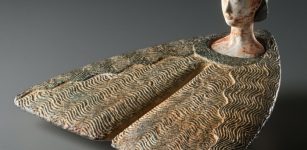 Strange Flat Idol Sculpture From Bactria Remains Unexplained
Artifacts | Sep 26, 2019
Strange Flat Idol Sculpture From Bactria Remains Unexplained
Artifacts | Sep 26, 2019 -
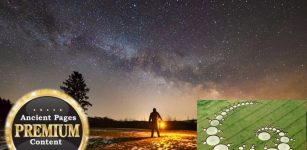 Crop Circles: Are They Cosmic Messages That We Cannot Decipher?
Featured Stories | Mar 26, 2019
Crop Circles: Are They Cosmic Messages That We Cannot Decipher?
Featured Stories | Mar 26, 2019 -
 On This Day In History: Fascinating Prague Astronomical Clock Mentioned For The First Time – On Oct 9, 1410
News | Oct 9, 2016
On This Day In History: Fascinating Prague Astronomical Clock Mentioned For The First Time – On Oct 9, 1410
News | Oct 9, 2016 -
 On This Day In History: Francis Baily First Observed ‘Baily’s Beads’ – On May 15, 1836
News | May 15, 2016
On This Day In History: Francis Baily First Observed ‘Baily’s Beads’ – On May 15, 1836
News | May 15, 2016 -
 Evil God-Bird Anzu Who Stole The Tablet Of Destiny To Control Universe and Fates Of All
Featured Stories | Aug 8, 2016
Evil God-Bird Anzu Who Stole The Tablet Of Destiny To Control Universe and Fates Of All
Featured Stories | Aug 8, 2016 -
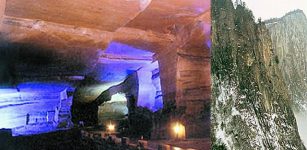 Incredible Technology In Mysterious Huashan Caves, China
Civilizations | Feb 10, 2015
Incredible Technology In Mysterious Huashan Caves, China
Civilizations | Feb 10, 2015 -
 Denisovan Family Tree: New Branches Revealed In Ancient DNA
Archaeology | Apr 12, 2019
Denisovan Family Tree: New Branches Revealed In Ancient DNA
Archaeology | Apr 12, 2019 -
 Fascinating Portable Art From Torre Cave, Gipuzkoa – One Of The Most Complete Specimens From The Entire Iberian Peninsula
Archaeology | May 26, 2023
Fascinating Portable Art From Torre Cave, Gipuzkoa – One Of The Most Complete Specimens From The Entire Iberian Peninsula
Archaeology | May 26, 2023
